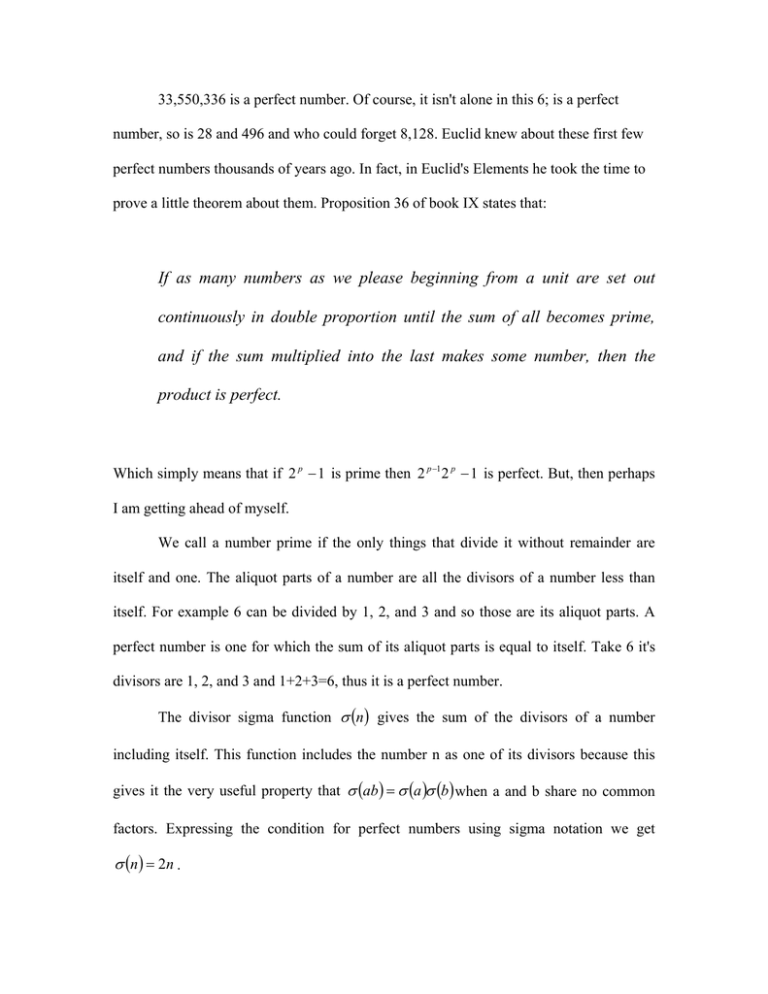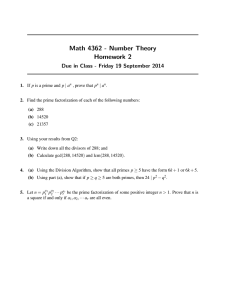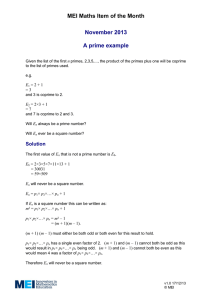33,550,336 is a perfect number. Of course, it isn't alone... number, so is 28 and 496 and who could forget...
advertisement

33,550,336 is a perfect number. Of course, it isn't alone in this 6; is a perfect number, so is 28 and 496 and who could forget 8,128. Euclid knew about these first few perfect numbers thousands of years ago. In fact, in Euclid's Elements he took the time to prove a little theorem about them. Proposition 36 of book IX states that: If as many numbers as we please beginning from a unit are set out continuously in double proportion until the sum of all becomes prime, and if the sum multiplied into the last makes some number, then the product is perfect. Which simply means that if 2 p − 1 is prime then 2 p −1 2 p − 1 is perfect. But, then perhaps I am getting ahead of myself. We call a number prime if the only things that divide it without remainder are itself and one. The aliquot parts of a number are all the divisors of a number less than itself. For example 6 can be divided by 1, 2, and 3 and so those are its aliquot parts. A perfect number is one for which the sum of its aliquot parts is equal to itself. Take 6 it's divisors are 1, 2, and 3 and 1+2+3=6, thus it is a perfect number. The divisor sigma function σ (n ) gives the sum of the divisors of a number including itself. This function includes the number n as one of its divisors because this gives it the very useful property that σ (ab) = σ (a )σ (b ) when a and b share no common factors. Expressing the condition for perfect numbers using sigma notation we get σ (n ) = 2n . The sigma notation makes things much easier, for instance a simple proof of Euclid's result is easily made. If n = 2 p −1 2 p − 1 and 2 p − 1 is prime then σ (n ) = σ (2 p −1 )σ (2 p − 1). Since 2 p − 1 is prime the sum of its divisors is simply itself plus 1. Since 2 p −1 is a power of two its divisors are just all of the powers of two less than or ( ) equal to it meaning that σ 2 p −1 = 2 p − 1 . Thus the product of the two is σ (n ) = σ (2 p −1 )σ (2 p − 1) = (2 p − 1)2 p = 2(2 p − 1)2 p −1 = 2n and thus n must be perfect. With a slightly more complicated proof Euler was able to show that any even perfect number must in fact be of the form discussed above. The prime 2 p − 1 in the factorization of this number is called the Mersenne prime after Marin Mersenne who investigated numbers of that form. Mersenne primes have enjoyed quite a bit of attention with a distributed computer search being carried on over the internet. Over its history the Great Internet Mersenne Primes Search or GIMPS has checked and double checked all the numbers 2 n − 1 for primality up to n = 14,001,400 providing us with most of our known Mersenne primes and therefore with their associated perfect numbers as well. The results on odd perfect numbers are numerous, but much less powerful; we don't even know whether an odd perfect, in fact, exists. Descartes saw no reason that there should be no odd perfect numbers. In a letter to a friend he noted that the number 3 2 7 211213 2 22021 would be an odd perfect number were 22021 prime. Euler proved that if they exist they must be of the form n = (4m + 1) 4 n+1 k 2 . The restrictions upon an odd perfect number, should one exist, are piling up one on top of another. Odd perfect numbers if they exist must be bigger than 10 300 , must contain a prime in their factorizations greater than 10 8 , and must contain at least 9 distinct prime factors or 11 distinct prime factors if 3 is not a factor. If one exists, then an odd perfect must be less than 24 k where k is its number of distinct prime factors. Although the last result is helpful in theory it is still much too large to be useful in searches for odd perfects. Just plugging in the minimum of 9 distinct primes we get that n if it exists must be less than about 10 78913 for which needless to say is not plausible to do a comprehensive search. One thing is very clear from all of this and that is that if an odd perfect number does in fact exist it is extremely large. A heuristic based on an analogy between abundants and perfects provides a very large prediction of an odd perfect numbers size. An abundant number is one whose aliquot parts add up to more than itself. Abundant odd numbers are also fairly hard to come by. The first abundant number is 12 but the first odd abundant number is 945. A quick analysis of the rate at which abundant numbers increase shows a remarkably linear increase. 300 250 y = 4.1519x + 8.8588 R2 = 0.9988 200 Series1 Linear (Series1) 150 100 50 0 0 10 20 30 40 50 60 70 If we assume that about one in four numbers is abundant we get a fairly good model at least for small numbers. Knowing that the first odd abundant number is 945 we would estimate that it would be about the 945/4=236th abundant number. A quick Pari script showed that in fact 945 is the 232nd abundant number. Now perfect numbers are extremely rare. The fourth one is in the millions and very soon they rocket into the stratosphere. There are only 44 known to date with the largest one having 9,808,358 digits. A linear regression on the exponents of the Mersenne primes isn't nearly as satisfying as it was for the abundant numbers giving an r 2 value of 0.2642. An exponential is a much better fit with an r 2 of .982133. 45000000 40000000 0.3945x y = 1.6864e 2 R = 0.9932 35000000 30000000 25000000 Series1 Expon. (Series1) Linear (Series1) 20000000 15000000 10000000 y = 110372x - 1E+06 2 R = 0.2644 5000000 0 0 -5000000 5 10 15 20 25 30 35 40 45 50 However, if we use the best fit exponential of the Mersenne exponents versus the number of Mersenne primes up to that, then if we assume that the first odd perfect shows up analogously late as the abundant odd numbers then we are looking at numbers which would be about 1010 39 . Of course all the memory in my desktop computer could only 11 just barely hold a single number of a size of about 1010 . Arithmetic on such a large number would be essentially impossible with today’s computational capabilities. I endeavored to model the sigma function with simpler functions. The sigma function is extremely irregular increasing and decreasing seemingly at random. The reason for its jumpiness is that the value of sigma is related to the factorization of the number which is very hard to predict. But if you know how the number is going to factor then the sigma function is not hard to figure out. For instance consider the sigma function for primes. If n is prime then σ (n ) = n + 1 . In fact so long as we only allow there to be one unknown prime in the factorization of n then we can replace σ (n ) with a monotonic function. While the sigma function seems to jump around mostly at random we can model it with several functions which only increase. We just need to keep an eye out that we know which function has the valid value at a particular position. 180 160 140 120 100 80 60 40 20 0 1 6 11 16 21 26 31 36 41 46 51 56 61 66 If you know all the primes but one in the factorization of a number then you can replace that number with the function a δ a ( x) = ∑ x i =0 i a . When x is of the form p a then δ a ( x ) will give the correct sigma. In order for the delta to be a replacement for the sigma function for the case of powers of single primes we need to create a family of functions, one function for each integer a>0. For numbers of a more general form we can separate out all but one prime into a separate factor k to get a class of monotonic functions which together cover all the points of the sigma function. The functions would be of the form ⎛n⎞ ⎟ ⎝k ⎠ σ ( n ) = σ ( k )δ a ⎜ . which would yield the correct value of σ (n ) when k||n and n is of the form p a . k






